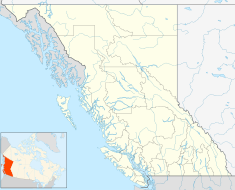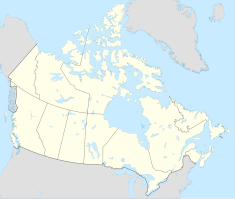Tashme Incarceration Camp
This article may rely excessively on sources too closely associated with the subject, potentially preventing the article from being verifiable and neutral. (August 2022) |
| Tashme Incarceration Camp | |
|---|---|
| Location | Sunshine Valley, British Columbia |
| Coordinates | 49°16′28″N 121°14′58″W / 49.27444°N 121.24944°W |
| Area | 600 acres |
| Founded | 1942[1] |
| Demolished | 1946[1] |
The Tashme Incarceration Camp (/ˈtæʒmɪ/ [Anglicized pronunciation] or /ˈtɑːʃɪmɪ/ [Japanese pronunciation]) was a purpose-built incarceration camp constructed to forcibly detain people of Japanese ancestry living on the West Coast of Canada during World War II after the attack on Pearl Harbor. Located at the current unincorporated community of Sunshine Valley, east of Hope in British Columbia, Canada, Tashme was operational between 1942 and 1946 and had a peak population of 2,624 people[2] to 2,636 people.[3] Tashme was constructed on 600 acres of leased land for $500/year on the A.B. Trites Farm.[4]
Name
The name Tashme was created by combining the first two letters of the last names of three men who worked for the BC Securities Commission, a now-obsolete branch of the Provincial Government. TAylor SHirras and MEad, after Austin Taylor, John Shirras and Frederick Mead.[4] Although it sounds like it could be a Japanese word, the name proved difficult to pronounce for Japanese-speaking inhabitants as the short sh sound without the vowel i following it is not seen in the Japanese Language. In English the name is commonly pronounced tahj-mi, versus the Japanese pronunciation of ta-shi-mi.
History
Since the 1860s, Japanese people had settled in British Columbia, working as lumbers or fishermen on the coast while facing racial struggles to be accepted in a predominantly white culture. Japanese immigrants worked hard and raised their own families; in 1941, the government recorded 13,000 Nissei, second-generation Japanese Canadians. Most Nisei were living in the Downtown east side, known as Japantown. In the heart of Japantown, on Oppenheimer Park, would form a historical baseball team that influenced the Vancouver baseball culture: Asahi.
The internment of Japanese Canadians was initiated from fears of Japanese forces after the attack on Pearl Harbor in 1941. In the first few months of 1942, the hate against Nisei, who only knew Canada as their home, had peaked, and racist stances against Japanese Canadians became hard to endure. Nevertheless, under Prime Minister Mackenzie King, the government issued an "Order-in-Council PC 1486"[5] for national security reasons. The legislation was to remove "all persons of Japanese Racial Origin" from 100 miles far from the BC west coast to the interior lands. The Japanese incarceration was one of Canadian history's worst violations of freedom. The BCSC, the British Columbia Security Commission, fixed the power for the RCMP to remove Japanese Canadians from their home forcefully, set dusk to dawn curfews, and confiscate personal properties.
Previously named Fourteen Mile Ranch, Tashme was the largest Japanese-Canadian incarceration camp in British Columbia, peaking its population at 2600 people. The site chosen for Tashme was 22km southeast of the village of Hope and on the border of the 100-mile coastal exclusion zone. It was surrounded by the Cascade mountains in a picturesque but isolated setting. In July 1942, the Tashme Incarceration Camp opened for Japanese Canadians. Nikkei were forced into unsanitary shacks and were pressured to construct houses starting in 1942. The camp was designed to house the families of men employed to work on constructing the Hope-Princeton highway, and was one of several road camps.[4] Tashme was the only internment site that was built for the purpose of Japanese Canadian internment, while the other sites were in ghost towns or villages.[6] Interned Japanese Canadian men were taken from Hastings Park to built Tashme before other internees moved in.[7] Construction on the site began in 1942 and, like other incarceration sites, Tashme was constructed hastily with limited materials, leading to a difficult first winter. Accounts of the winter of 1942-1943 are that it was particularly cold with heavy snowfall. Even after the war, Japanese Canadians were banned from returning home from the internment camps until 1949, and even worse, their homes were sold at bargain basement prices by the government. Tashme, as an internment camp, closed on August 26, 1946,[1] a year after World War II ended, and was fully dismantled in October 1946. The Canadian government encouraged Niseis to either move east of the Rocky Mountains or move to Japan. With no home to return to, most Nikkei chose repatriation, though they were foreigners in the eyes of citizens in Japan. All Japanese Canadians who chose repatriation were collected in Tashme and were forcefully sent to Japan. The internment of Japanese Canadians was the government's response to the public pressure against the Japanese race during the heightened hate against the Japanese force during the war.
Camp conditions and facilities
Internees at Tashme were mainly housed in quickly-constructed tarpaper shacks. There were 347 shacks, each approximately 14x28 feet. 1-2 families, or up to 8 people, would stay in one shack. The undried, green timber that was milled quickly to construct the cabins shrunk as it dried, creating drafts in the tarpaper shacks.[4] Green timber was also provided as firewood, but it was difficult to light. When a fire was lit inside the shack, more water was drawn out from the green timber of the walls and would freeze after the fire went out.[8] These houses were laid out on 10 avenues, with around 30 houses on each avenue, and every four houses would share a common outdoor tap as well as an outhouse.
References
- ^ a b c Shimokura, Howard. "Timeline". Tashme Historical Project. Retrieved 4 August 2022.
- ^ Shimokura, Howard. "www.tashme.ca". Tashme. Retrieved 4 August 2022.
- ^ NNMCC (2013). Karizumai: A Guide to Japanese Canadian Internment Sites (2nd ed.). Nikkei National Museum and Cultural Centre. p. 9.
- ^ a b c d Adachi, Ken (1976). The Enemy that Never Was (First ed.). Toronto, Canada: The Canadian Publishers. p. 253. ISBN 0-7710-0723-X. Retrieved 4 August 2022.
- ^ "Order of Council PC 1486". Redress Causevox. Regina Japanese Canadian Club Inc. Retrieved 1 August 2022.
- ^ Enomoto, Randy (2016). Honouring Our People: Breaking The Silence. Greater Vancouver Japanese Canadian Citizen's Association.
- ^ "Tashme Internment Camp". Canada's Historic Places.
- ^ "Tashme- Japanese Internment Camp- 1942-1946" (PDF). Retrieved 24 August 2022.


